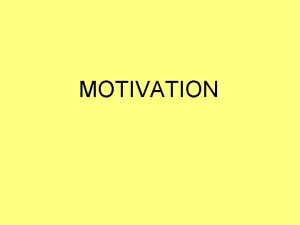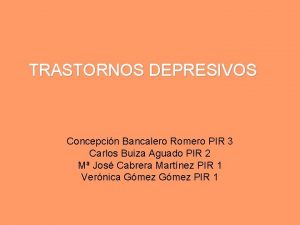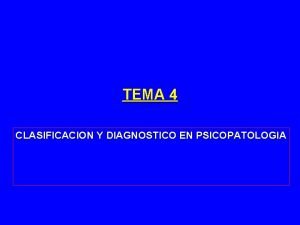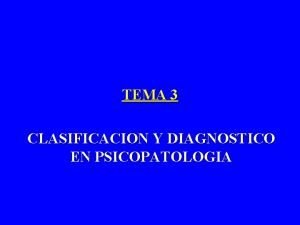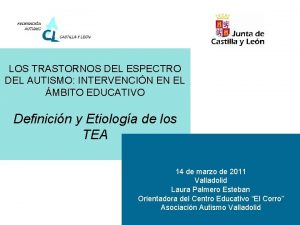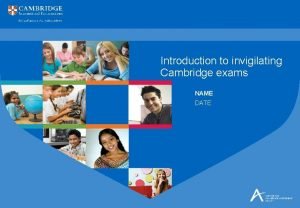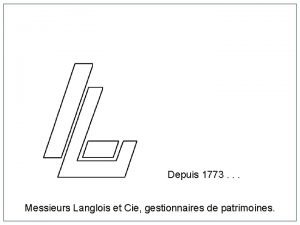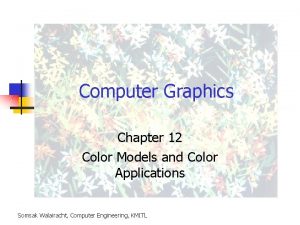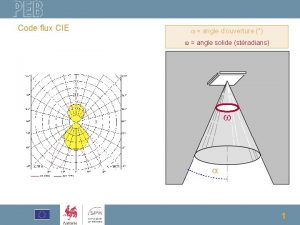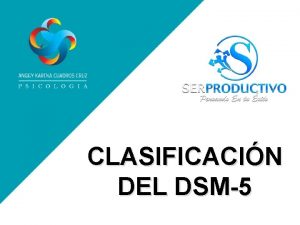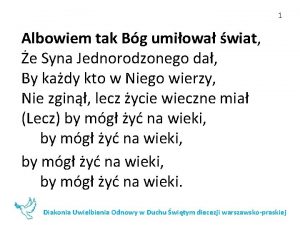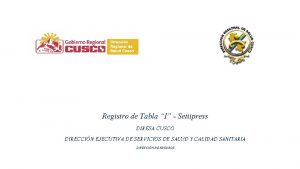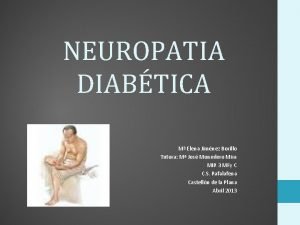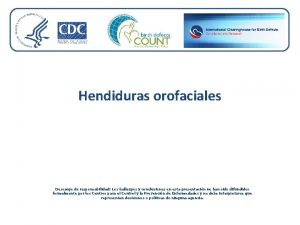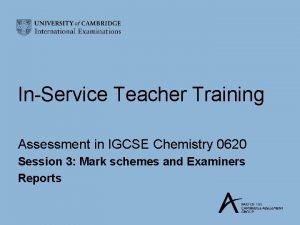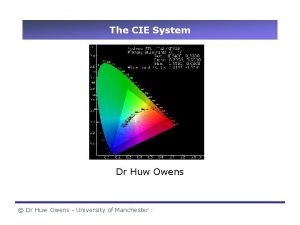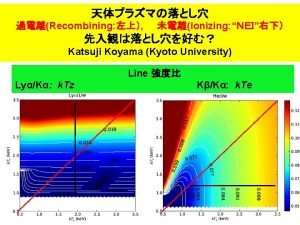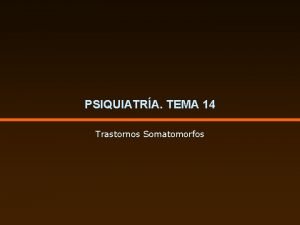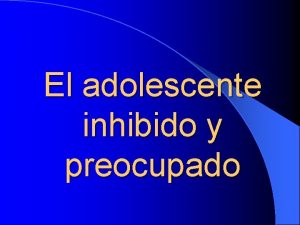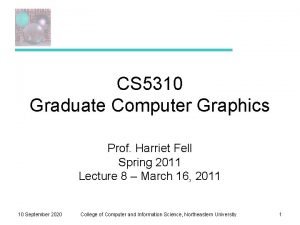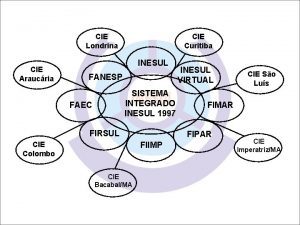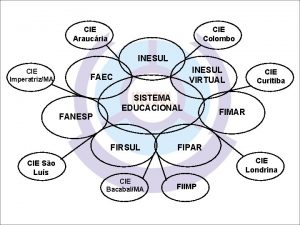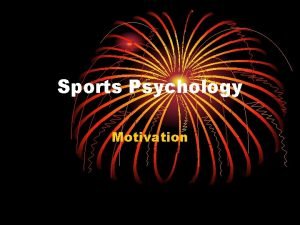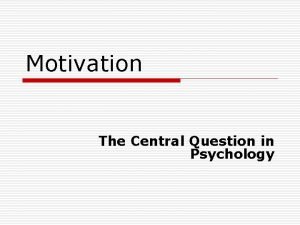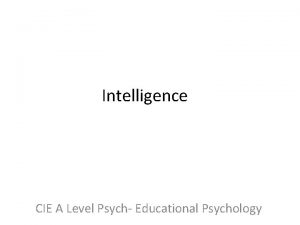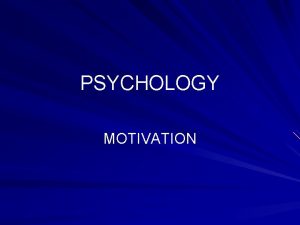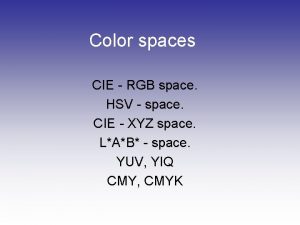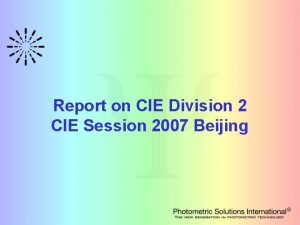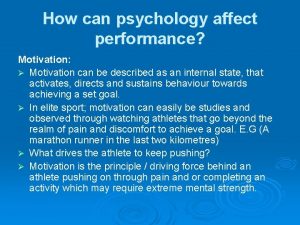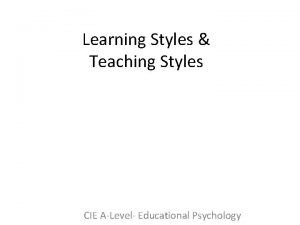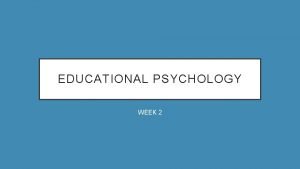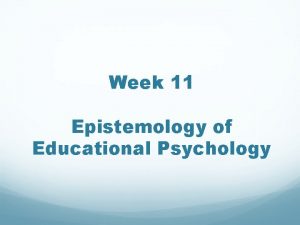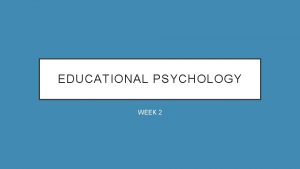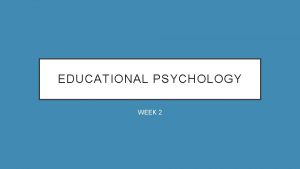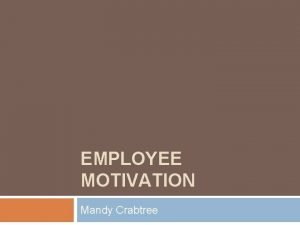Motivation Educational Performance CIE A Level Educational Psychology











































- Slides: 43

Motivation & Educational Performance CIE A Level- Educational Psychology

CIE Syllabus Components for Motivation & Educational Performance • Bullet 1: Definitions, Types, & Theories of Motivation – Definition of Motivation – Types: Intrinsic & Extrinsic – Theoretical Basis: Behaviorist (Skinner, 1952), Cognitive (Mc. Clelland, 1953), and Humanistic (Maslow, 1970) • Bullet 2: Improving Motivation – Behavioral Technique- Brophy’s (1981) Effective Praise – Cognitive Technique- Mc. Clelland’s (1953) Need for Achievement – Cognitive-Behavioral Technique- Bandura’s (1977) Self-efficacy • Bullet 3: Motivation Issues – Attribution Theory -Weiner (1984) – Learned Helplessness- Dweck et al. (1978) – Changing Attributions- Self-Determination Theory (SDT) (Deci & Ryan, 1985; 2000)

CIE Syllabus Components • Topic 1: Definitions, Types, & Theories of Motivation – Definition of Motivation – Types: • Intrinsic & Extrinsic – Theoretical Basis: • Behaviorist – Skinner (1952) Rewards and Punishments • Cognitive – Mc. Clelland (1953)- Need for Achievement (n. Ach) • Humanistic – Maslow (1970) Hierarchy of Needs

Defining Motivation- generally viewed as a need of some sort Schunk (2008) defines it as “the process whereby goal-directed activity is instigated and sustained” Influences our thoughts and actions Can be situation specific and in general For educational applications: Researchers focus on why students learn & why some have a greater desire to learn than others Motivation has been seen to be the primary factor influencing test performance and overall school success Motivated students also have better attendance, positive outlooks in school, are more persistent on difficult tasks, and show less behavioral issues

Types of Motivation Intrinsic Motivation Internal drive to partake in an activity as the task itself is rewarding In school, one’s thoughts & actions are based on an internal desire to learn about topics Such as natural curiosity about clownfish Extrinsic Motivation- External drive to partake in an activity as the task is a means to an end (complete a task as it is required) In school, one’s thoughts & actions are based on requirements to completing assignments, study for tests, and so on which are external pressures to do well Such as pretty much anything as a senior

Theoretical Basis for Motivation: Behavioral- Skinner (1952) • Foundation of operant conditioning – Reinforcement increases motivation in students – Avoiding punishment should also increase motivation • Whereas being punished should decrease motivation in students • Support of behaviorist outlook: – Research has shown that rewards in school (test grade, sticker, line leader) sustain/increase motivation – Schunk et al (2008) noted that praise, comments on homework, and good grades function as motivators in the classroom – Covington (2000) noted that rewards that recognize increasing achievement/understanding increase intrinsic motivation

Theoretical Basis for Motivation: Behavioral- Skinner (1952) • Critiques of behavioristic outlook: – Rewarding students for learning sends the wrong message about education (Kohn, 1996) • Such as $ for grades turns learning from intrinsic to extrinsic, posing a problem for when the rewards are stopped – Notion that behaviorism cannot adequately explain motivation • Such as if a student believes s/he cannot be successful or is able to complete a difficult task, despite potential rewards, the explanation is than a cognitive one (not behaviorist)

Theoretical Basis for Motivation: Cognitive- Mc. Clelland (1953) Cognitive theories are concerned with the way we think about our behavior and the strategies that we use in order to achieve our goals Based on the idea that we have a goal in mind and thus we are motivated to work towards this goal Influenced by prior knowledge and experiences Mc. Clelland (1953) The Achievement Motive Need for Achievement (n. Ach) and Need to Avoid Failure (n. AF) conflict Students will undertake activities as they want to be successful Various external factors play a role as well (wanted praise from teacher & peers, to please parent/guardian, top of the class, etc. ) Influenced by ideas of cognitive dissonance & disequilibrium

Theoretical Basis for Motivation: Cognitive- Mc. Clelland (1953) • In measuring n. Ach, the TAT (thematic apperception test) measures responses to stories relating to one’s needs of achievement, affiliation, and power • Kagan & Lang (1978)- note that we are capable of forming cognitive representations (thoughts, wishes, desires), helping to motivate us – We can ‘see’ what we want to happen and then direct our behavior towards achieving that goal – In the classroom, teachers can build upon the needs of their students and plan accordingly to motivate them

Theoretical Basis for Motivation: Humanistic- Maslow (1970) • Based on Maslow’s hierarchy – Review from the Perspectives on Learning Unit • Maslow says that motivation is categorized into 2 sets of needs that are arranged in a hierarchy – Deficiency- physiological, safety, belongingness/love, & esteem – Growth- (cognitive, aesthetic), self-actualization • In order for a person to ‘climb’ the hierarchy, the level below must be satisfied before being able to go to the next higher one • At the apex of self-actualization, one realizes and reaches one’s full potential (only for a brief period though)

Theoretical Basis for Motivation: Humanistic- Maslow (1970)

Theoretical Basis for Motivation: Humanistic- Maslow (1970) • This outlook has tremendously impacted schools, with programs such as free/reduced lunches and aftercare • The humanist teacher focuses on student motivation by: – Acting as a facilitator of knowledge (rather than disperser) • Promote students to be autonomous – Focusing on building student’s self-esteem

Theoretical Basis for Motivation: Humanistic- Maslow (1970) • Holdbacks of Maslow’s Theory – Methodology- Purely subjective by Maslow in deeming that people have self-actualized • Increased probability of experimenter bias and invalid data • Concept of self-actualization cannot be scientifically measured – His ideas of what consisted of self-actualization may be ethnocentrically biased – Criticism over Maslow's assumption that the lower needs must be satisfied before a person can achieve their potential and selfactualize

Theoretical Basis for Motivation: Humanistic- Maslow (1970) • Strengths of Maslow’s Theory – Heavily influenced the field of psychology to look at the cognitive side of why people do what they do – Has been extremely influential in schools • Free/reduced lunch programs, before & after school programs, bullying, etc.

CIE Syllabus Components • Topic 2: Improving Motivation – Behavioral Technique • Brophy’s (1981) Effective Praise – Cognitive Technique • Mc. Clelland’s (1953) Need for Achievement (n. Ach) and Need to Avoid Failure (n. AF) – Cognitive-Behavioral Technique • Bandura’s (1977) Self-efficacy

Improving Motivation: Behavioral- Brophy (1981) • Brophy (1981) focuses on classroom variables and effective praise for motivation in school settings – Based upon positive reinforcement concept – Noted that often the “good job” praise is not enough – Noted that many times teachers fail to implement minor changes that can increase student motivation and consequently facilitate learning – Said that only about 6% of class time is devoted to praise (not enough)

Improving Motivation: Behavioral- Brophy (1981) Components of Effective Praise should be delivered in response to a specific behavior Praise should be sincere, credible, and spontaneous Praise should reward the attainment of clearly defined and understood performance criteria Praise should provide information about the student's competencies Praise should be given in recognition of noteworthy effort or success at a difficult task for that particular student Praise should attribute success to effort and ability (implies similar success in the future)

Improving Motivation: Behavioral- Brophy (1981) Components of ineffective praise Is delivered randomly or unsystematically Is restricted to global positive reactions delivered in a bland fashion with minimal attention to the student or behavior Compares the student's performance to other students Is given without regard to the effort needed to complete the task Attributes success to ability alone or to external factors such as luck or the ease of the task Is given by the teacher who acts as a power figure and external authority in a manipulative manner

Improving Motivation: Behavioral- Brophy (1981) Brophy focused on aspects of the class that teachers could utilize to increase student motivation (aside from praise): Student interest -relate subject of study to what students like Student needs- motivated when activities meet some basic needs- like group work in HS to social needs Novelty & variety- mix up activities, shorter lectures, etc Success- make goals/objectives clear, teach in small steps, check for understanding Student attribution for success & failure -failure should be seen as lack of effort, not of ability Tension- by walking around, quizzing, and the like, teachers remind students of work that needs to be accomplished Feeling tone- class climate

Improving Motivation: Behavioral- Brophy (1981) • Evaluating praise as a motivational strategy – Strengths • Research has shown that praise can be very effective, especially for lower achieving students, those from lower SES backgrounds, for boys, and for students with an 'external locus of control' • It is a very simple and time-efficient strategy that requires no additional planning or monitoring • As it is used in schools and businesses globally, theory has useful and important applications to the real world

Improving Motivation: Behavioral- Brophy (1981) • Evaluating praise as a motivational strategy – Weaknesses • It may not be effective for many students • It is only effective if used properly – If not, praise can have a reverse effect and can decrease motivation • It is deterministic as it promotes no self-choice for students to change their behavior or their own motivation • May raise ethical issues of consent as teacher can ‘manipulate’ students’ motivation without their consent

Improving Motivation: Cognitive- Mc. Clelland (1953) • Need to determine if the student fits into the Need for Achievement (n. Ach) or Need to Avoid Failure (n. AF) category • Motivating those who focus on Need to Avoid Failure (n. AF) – Since these students have a low n. Ach, they will instead seek out easy tasks so they can avoid failing at the more challenging ones – Provide opportunities that are easy enough for them to be successful on – Avoid promoting competition among peers – Try changing the notion of ability being a factor of failing

Improving Motivation: Cognitive- Mc. Clelland (1953) • Motivating those who focus on n. Ach: – Students should have opportunities where they can compete against a ‘set standard’ like grades or peers in the class – Provide opportunities to increase problem-solving skills and manners in dealing with setbacks – Provide opportunities for students to overcome challenges and to show growth • Other ways that teachers can increase n. Ach: – – Encourage parents to promote autonomy at home and in the school Praise and reward students’ success Associate achievement with positive feelings Associate achievement with one's own competence and effort, not luck

Improving Motivation: Cognitive-Behavioral- Bandura (1977) • Self-efficacy and increasing student motivation – Define: A measure of the belief about our own ability to complete tasks successfully and achieve goals – while self-efficacy indicates how strongly a student believes s/he has the skills to do well, s/he may believe other factors will keep him/her from succeeding • Research shows a positive, significant relationship b/w students' self-efficacy & their academic performance as it influences: – Which activities that they partake in – How much effort they put into the task – How persistent they are when faced with adversity

Improving Motivation: Cognitive-Behavioral- Bandura (1977) • Students with high self-efficacy: – – View challenging problems as tasks to be mastered Develop deeper interest in the activities in which they participate Form a stronger sense of commitment to their interests and activities Recover quickly from setbacks and disappointments

Improving Motivation: Cognitive-Behavioral- Bandura (1977) • Students with low self-efficacy: – Avoid challenging tasks – Believe that difficult tasks and situations are beyond their capabilities – Focus on personal failings and negative outcomes – Quickly lose confidence in personal abilities

Improving Motivation: Cognitive-Behavioral- Bandura (1977) • Increasing one’s motivation is based on 4 categories: – Personal accomplishments • Previous success increases our self-efficacy (failure lowers it) – Vicarious experience • Seeing someone else like you being successful provides you confidence to be successful as well – Verbal persuasion • Verbal praise from parents, (most) teachers, & peers can instill confidence – Emotional arousal • Moderate amount of anxiety/stress is optimal for self-efficacy to work well

Increasing Motivation Techniques Intrinsic Extrinsic • Explain or show why learning a particular content or skill is important • Allow students some opportunities to select learning goals and tasks • Create and/or maintain curiosity • Provide a variety of activities and sensory stimulations • Provide games and simulations • Set goals for learning • Relate learning to student needs • Help student develop plan of • Provide clear expectations • Give corrective feedback • Provide valuable rewards for simple learning tasks • Make rewards available • Allow opportunities for students to observe more correct exemplars • Allow for opportunities to engage in social learning activities • Provide for scaffolding of corrective feedback

CIE Syllabus Components • Topic 3: Motivation Issues – Attribution Theory • Weiner (1984) – Learned Helplessness • Dweck et al. (1978) – Changing Attributions- Self-Determination Theory (SDT) • (Deci & Ryan, 1985; 2000)

Motivation Issues: Attribution Theory (Weiner, 1984) • Weiner (1984) suggests that attributions can be classified by three categories: – Locus of control- the cause of success or failure originates within us or in the environment (internal vs. external) – Stability- factors (like luck or skills) that affect our behavior over time (stable vs. unstable) – Controllability- cause of success/failure something that we have or do not have control over (controllable vs uncontrollable) • We also make different attributions depending on whether the outcome of the behavior has positive or negative consequences for us (example in chart)

Motivation Issues: Attribution Theory (Weiner, 1984)

Motivation Issues: Attribution Theory (Weiner, 1984) • We tend to view the results in such as way to maintain a positive self-image – Our successes are because of our abilities/efforts – Our failures are because of external variables (bad teaching/luck) • Attribution theory & motivation in education (4 factors) – Ability- a relatively internal and stable factor over which the learner does not exercise much control – Effort- internal & unstable factor over which the learner can exercise a great deal of control – Luck- external & unstable factor over which the learner exercises very little control – Task difficulty- an external & stable factor that is largely beyond the learner’s control

Motivation Issues: Attribution Theory (Weiner, 1984)

Motivation Issues: Attribution Theory (Weiner, 1984) • A student’s perceptions/attributions for success & failure determine the amount of effort s/he will put into the activity in the future • As mentioned before, research from attribution theory notes ways to change/increase student motivation: – Promote their strengths and note that the occasional failures are the result of external factors (like bad luck or lack of effort) – Utilize tasks that create opportunities for students to be successful – Provide positive examples of when students did well after putting in the – Focus on student’s increasing achievement rather than competition w/others – If student believes s/he lacks ability, it is necessary to take steps to alter this

Motivation Issues: Attribution Theory (Weiner, 1984) • Attribution theory ties the behavioral & cognitive theories together • In understanding attribution theory, you should be able to understand: – (a) Why praise is effective for some people and not others • people with an internal locus of control will respond better to praise than people who think that their performance is out of their control – Brophy (1981) found that praise is best for students with external locus – (b) The Need for Achievement theory • high N-Ach people will tend to make internal attributions, whereas low N-Ach people will make external ones – (c) Self-efficacy • feeling in control will mean that you are making internal attributions, which is usually a more positive thing than external attributions

Motivation Issues: Attribution Theory (Weiner, 1984) • In understanding attribution theory, you should be able to understand: – (d) Learned helplessness • if you make external, stable, uncontrollable attributions to the situation, then you’re going to feel helpless – (e) Changing attributions • if you want to get people to make internal, unstable, and controllable attributions instead, then it makes sense that you emphasize internal, unstable, controllable things. . . such as effort

Motivation Issues: Learned Helplessness (Background) Seligman (1967)- showed that once dogs were placed in an inescapable traumatic situation, they gave up trying to escape even when possible In the same sense, students who often fail, are told that they are nothing, or the like feel as though whatever they do, they will not be successful in school If a student fails a test and attributes it to lack of effort, they believe that they can be successful when they study the next time, BUT… If a student fails a test and attributes it to their lack of ability and believe that whatever they do will not work, they will most likely give up trying and accept the idea that they will fail

Motivation Issues: Learned Helplessness (Dweck et al. , 1978) Dweck et al (1978) discovered that learned helplessness in school is influenced by the quantity & type of feedback that students receive – Girls were more likely to attribute failure to lack of ability – Boys were more likely to attribute failure to lack of effort or intrusion of the experimenter Study 1 - Observational- 4 th & 5 th grade classes Observed a classroom and categorized the feedback into (a) positive or negative, (b) behavior or work-related, and (c) intellectual or non -intellectual from the teachers Findings showed that teachers tended to provide the same amount of feedback b/w the genders, BUT… Girls received significantly lower amount of pos feedback & higher amounts of negative feedback about the quality of their work

Motivation Issues: Learned Helplessness (Dweck et al. , 1978) • Study 2 - Experimental- kids solving anagrams – Task was for the students to solve various anagrams (some solvable & some not) where the Es maintained the same patterns of genderbiased feedback (favoring the boys of course) – Children were then asked to solve problems, but they were never allowed to finish them. All of the children were told that they had not done well on these final problems. – Findings showed that the girls were more likely to attribute this failure to a lack of ability, whereas boys attributed it to a lack of effort or to the experimenter being too strict. • In both studies, learned helplessness was displayed by the girls in that they started to make internal, stable, and uncontrollable attributions about their low scores, incorrect answers, inability to solve the anagrams, and so on.

Motivation Issues: Learned Helplessness (Dweck et al. , 1978) • Research on learned helplessness (by Dweck and others) can be useful: • Displays that the quality & frequency of feedback (in particular negative) on children's work can have an effect on their likelihood of developing learned helplessness • ‘Reinforces’ Brophy’s concept that effective praise is best suited instead • ‘Reinforces’ notion that behavioral reinforcements (a gold sticker!) can better lead to wanted change rather than punishments (detention) • Reinforces the humanistic notion in that each student has potential to be successful as they see fit

Motivation Issues: Changing Attributions (Self-Determination Theory-SDT) • Self-Determination Theory- (Deci & Ryan, 1985; 2000) • Suggests that people tend to be driven by a need to grow as a person and gain fulfillment, and thus we are actively directed toward achieving this – Foundations of humanistic & cognitive and theory • Theory states that gaining mastery over challenges and taking in new experiences are essential for developing a cohesive sense of self • SDT focuses primarily on internal sources of motivation such as a need to gain knowledge or independence – For theory, social support is the main focus – Through our relationships and interactions with others, we can either foster or thwart well-being and personal growth

Motivation Issues: Changing Attributions (Self-Determination Theory-SDT) • According to self-determination theory, people need to feel the following in order to achieve such psychological growth: – Competence: we need to gain mastery of tasks, learn new skills, and see an increase over time – Autonomy: we want to feel in control of our behaviors, goals, and environment – Relatedness: we need to experience a sense of belongingness with others (like Maslow) – (remember, we all need a CAR) • Theory suggests that when people experience these 3 things, they become self-determined and are able to be intrinsically motivated to pursue things that interest them

Motivation Issues: Changing Attributions (Self-Determination Theory) • Ways to help support students’ self-determinism – Deci notes that offering unexpected positive encouragement & feedback on a person's performance on a task can increase intrinsic motivation • This feedback helps add to the ‘competence’ category – Utilize lessons that incorporate students’ interests – Encourage students to set goals – Provide examples of how academic work relates to personal life & goals
 Strumienie życia płyną z mego serca
Strumienie życia płyną z mego serca Performance = motivation x ability
Performance = motivation x ability Performance = motivation x ability
Performance = motivation x ability Trastorno afectivo cie 10
Trastorno afectivo cie 10 Episodio depresivo cie-10
Episodio depresivo cie-10 Diagnostico multiaxial
Diagnostico multiaxial Diagnostico multiaxial cie 10
Diagnostico multiaxial cie 10 Diagnostico multiaxial cie 10
Diagnostico multiaxial cie 10 Soba en medicina
Soba en medicina Trastorno dismórfico corporal cie 10
Trastorno dismórfico corporal cie 10 Episodio depresivo cie-10
Episodio depresivo cie-10 Cie 10 autismo
Cie 10 autismo Invigilator cambridge
Invigilator cambridge F32 diagnostico
F32 diagnostico Ejes de la evaluacion multiaxial
Ejes de la evaluacion multiaxial Langlois et cie
Langlois et cie Hsv model in computer graphics
Hsv model in computer graphics Cie flux codes
Cie flux codes Dsm 4 y 5 diferencias
Dsm 4 y 5 diferencias Dzięki o boże ojcze
Dzięki o boże ojcze Wzywam cię przyjdź umocnij mnie
Wzywam cię przyjdź umocnij mnie Przemień o jezu smutny ten czas
Przemień o jezu smutny ten czas Cie 10 maps
Cie 10 maps Micro turner chakan
Micro turner chakan Bóg cię kocha i ma dla twojego życia wspaniały plan
Bóg cię kocha i ma dla twojego życia wspaniały plan Diresa cusco cie 10
Diresa cusco cie 10 Elenajimnez
Elenajimnez Cie+
Cie+ Tipos de labio leporino
Tipos de labio leporino Cie past papers chemistry
Cie past papers chemistry Cie bie accounting
Cie bie accounting Scope of educational psychology
Scope of educational psychology Cie color matching functions table
Cie color matching functions table Cie k
Cie k Trastorno somatomorfo cie-10
Trastorno somatomorfo cie-10 Szukalem cie wszedzie z petem w gebie
Szukalem cie wszedzie z petem w gebie Código cie 10
Código cie 10 Mahindra cie automotive ltd gear division
Mahindra cie automotive ltd gear division Cie liverpool
Cie liverpool Cie northeastern
Cie northeastern Cie curitiba
Cie curitiba Cie
Cie Definition of motivation in sport psychology
Definition of motivation in sport psychology Motivation types
Motivation types


